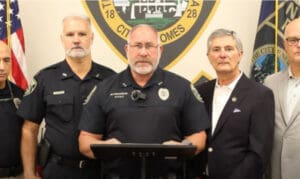Coweta County District Attorney Pete Skandalakis on Oct. 3 issued a decision in the November 2015 death of Florida resident Chase Sherman after a 911 call and an altercation involving deputies on Interstate 85 after which Sherman died. Skandalakis said the Sherman death is not a criminal matter and will not be prosecuted.
“After a thorough and careful review of the evidence in this case-including repeated viewings of the videos provided by the body-worn cameras of the Sheriffs Deputies involved-and upon consideration of the applicable law, I have made the following decision,” said Skandalakis. “The death of Mr. Chase Sherman, while tragic in nature, is not a criminal matter and, therefore, will not be prosecuted further under state law.”
According to Skandalakis, the evidence showed the following: on the evening of Nov. 20, 2015, Chase Sherman and his family were returning from a family wedding in the Dominican Republic. During his stay in the Dominican Republic, Mr. Sherman began experiencing bouts of paranoia, during which he believed, for example, that Dominican citizens posed a threat to him.
“The evidence fails to demonstrate fully why Mr. Chase Sherman was experiencing these delusional thoughts, though some family members speculated that Sherman’s altered mental state might have been due to ingesting a drug prior to or during the trip. Family members also reported that Sherman had little, if any, sleep while in the Dominican Republic,” the Skandalakis press release said.
Skandalakis said that, upon returning from the Dominican Republic and arriving at the Atlanta airport, Sherman’s family noticed Sherman had begun to act erratically. Because of the increasing unpredictability of Sherman’s behavior, the family decided to forego their connecting flight to Florida and instead rented a vehicle to drive home.
“According to family members, Sherman became agitated and without provocation began yelling at another a family member. While in the airport, due to Mr. Chase Sherman’s behavior, his family sought assistance from Atlanta Police Department officers stationed at the airport,” the press release said. “The family asked if Sherman could be taken into custody, but the officers determined they had no basis to arrest Sherman. Instead, after a minor incident with the officers, Mr. Chase Sherman was placed in the back seat of the rental vehicle.”
The family left the airport and drove south on Interstate 85 toward their home in Florida. While traveling on I-85 with his family and fiancee, Sherman’s behavior became increasingly erratic and bizarre, said Skandalakis.
“Believing he was in danger, even though he was safe with his family, Mr. Chase Sherman became highly agitated and combative. At one point, he sought to jump out of the moving vehicle onto the interstate. Family members prevented him from doing so and attempted to subdue him,” according to the press release. “It was at this time that emergency 911 received a call from a family member of Mr. Sherman pleading for assistance. The family member who called was frantic at times and described Mr. Sherman as ‘freaking out.’ The caller also stated, ‘he is going to cause us to wreck,’ ‘he is on some kind of drug,’ and, notably, ‘he is going kill us all.’”
When the 911 operator asked what caused Sherman to act like this, the family member responded, “Drugs. Drugs. He is hallucinating. He needs help. At other times the caller can be heard telling someone in the car to “hit him in the head, hit him in the stomach.” During this chaotic event, Sherman bit his fiancee, the press release said.
The 911 operator during the communication determined that the vehicle had stopped beside a median wall on I-85.
“When sheriff deputies arrived, they found the rental car stopped in a precarious position next to the median concrete divider with very little room for anyone to safely maneuver. Interstate traffic continued to zoom by at highway speeds,” said Skandalakis. “Upon approaching the vehicle, the deputies saw Mr. Chase Sherman in the back seat being restrained by a family member. Approaching the front passenger side window, the first sheriffs Deputy, Joshua Sepanski, tried to assess the situation by speaking to a family member.”
Skandalakis said the deputy gathered pertinent information then opened the only fully accessible back door. This door was on the same side as traffic traveling south on the interstate.
“The deputy struggled with Mr. Sherman but managed to handcuff him. Sherman, however, became extremely agitated, struggled further, and physically resisted the deputy,” the press release said. “In his altered mental state, Mr. Chase Sherman fought with the deputy, possibly believing the first responder was kidnapping him. It is unclear from the videos what Mr. Sherman was thinking, but it was clear that Sherman was acting under the influence of some delusion.”
Skandalakis said a second deputy, Samuel Smith, arrived to assist and attempted to enter the vehicle on the opposite side of the car. The second deputy was limited in his access to the vehicle because the door was partially blocked by the concrete barrier and could not be fully opened.
“While attempting to help restrain Mr. Chase Sherman, the second deputy discharged his Taser at Mr. Sherman. The two prongs from the Taser lodged closely together in Mr. Sherman’s back, which hampered the Taser’s effectiveness,” the press release said. “Sherman continued to fight with the deputies and managed at one point in the struggle to gain control of Deputy Sepanski’s Taser. As Sepanski and Sherman struggled over the Taser, the Taser prongs were discharged into the seat of the vehicle. Still attempting to restrain Sherman and help his partner, Deputy Smith “drive stunned” Sherman by pressing the Taser directly onto Sherman. The Taser again had minimal effect.”
At times during the videos, said Skandalakis, the Taser can be heard “arcing,” which, according to the Taser experts, indicates the Taser was not in full contact with the subject target.
The deputies continued to try to gain control of the situation and ordered Sherman’s family out of the car. Shortly thereafter, emergency medical services personnel arrived on scene, the press release said.
“Immediately recognizing the danger and chaos of the situation, one emergency medical technician rushed to help subdue Sherman. The EMT entered the front passenger side of the car and tried to assist the deputies,” the district attorney said. “As the occupants of the vehicle continued to struggle, the deputies and the EMT finally got Sherman on the floorboard of the backseat of the car. The EMT placed his knee on Sherman’s back while using the roof of the vehicle as leverage to hold Sherman in place. The deputies and the EMT can be heard on the video talking to Sherman attempting to calm him. Within minutes of being restrained, Chase Sherman stopped breathing.”
The press release continued, saying the deputies and the EMT then noticed a smell of fecal matter and that Sherman would not respond to their questions. They immediately pulled Sherman out of the vehicle and attempted to revive him, to no avail.
A GBI medical examiner performed an autopsy on Sherman and an independent lab tested Sherman’s blood for the presence of drugs and alcohol. The medical examiner determined Chase Sherman died as a result of the fatal combination of several factors, said Skandalakis.
“Sherman’s resistance, the altercation and the use of tasers all contributed to Sherman having an increased heart rate and an increased need for oxygen. During the struggle, Sherman’s capacity to breathe was restricted by the weight of the EMT and the compression upon Sherman’s chest. Sherman’s rapid heart rate and his increased need for oxygen caused him to asphyxiate,” Skandalakis said.
Additionally, according to the press release, the toxicology tests of Sherman’s blood failed to reveal the presence of any commonly used and known street drugs. Given the family’s previous statements about Sherman’s drug use at the time, the toxicology results were surprising and it cannot be determined if Sherman’s altered mental state was due to some previous drug use, a mental break, or the use of some unknown or synthetic substance.
“Thus, Sherman’s untimely death was ultimately the result of many contributing factors,” said Skandalakis. “Those factors include his altered state of mind which caused him to struggle thereby increasing his anxiety and heart rate, the physical confrontation he had with his family, the deputies and the EMT, the physical reaction of being subjected to a Taser and positional asphyxiation due to his position on the floorboard of the car with the EMT positioned on top of him.
“In reviewing all the evidence and considering these factors as a whole, it is the determination of this office that Sherman’s death was a tragic accident and not the result of anyone acting with the intent to harm him.”
Skandalakis said his consideration of the case has been deliberate, thorough and carefully considered. The only decision for the district attorney is whether or not under state law a crime has been committed and, if so, whether or not under state law the crime came be proved beyond a reasonable doubt.
“The district attorney cannot and does not attempt to decide whether the deputies, EMTs, or others could or should have acted differently,” according to the press release. “In this and in every case, it is the policy of the district attorney to consider the evidence without fear, favor, or affection for any of the parties involved. We have done so here. Undoubtedly, Mr. Sherman’s death is a tragedy and our hearts go out to his family for their great loss, but none of the parties involved have committed a prosecutable crime.”













Leave a Comment
You must be logged in to post a comment.